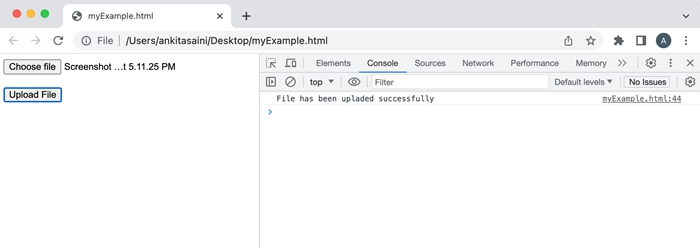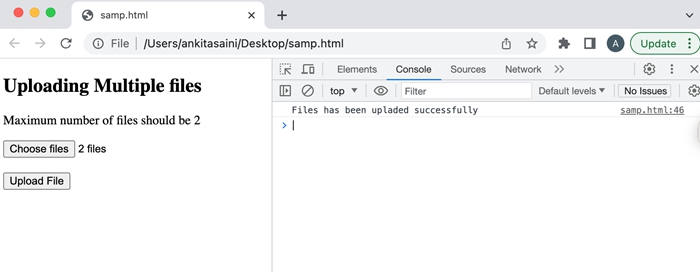Fetch API 提供了一种灵活的方法来创建 HTTP 请求,该请求会将文件上传到服务器。我们可以将 fetch() 函数与 FormData 对象一起使用,在请求中发送单个或多个文件。让我们借助以下示例来讨论这个概念 -
示例 - 上传单个文件
在下面的程序中,我们使用 fetch API 一次上传一个文件。在这里,我们使用 FormData 对象来存储文件,然后使用 fetch() 函数将其发送到给定的 URL,包括 POST 请求方法和 FormData 对象。将请求发送到服务器后,我们现在使用 then() 函数来处理响应。如果我们遇到错误,则该错误由 catch() 函数处理。
输出

示例 − 为单个输入上传多个文件
在下面的程序中,我们将使用 fetch API 从单个输入上传多个文件。这里我们在 <input> 标签中添加一个 “multiple” 属性来添加多个文件。然后我们使用 FormData 对象存储多个文件,然后使用 fetch() 函数将它们发送到给定的 URL,包括 POST 请求方法和 FormData 对象。将请求发送到服务器后,我们现在使用 then() 函数来处理响应。如果我们遇到错误,则该错误由 catch() 函数处理。
输出

示例 − 上传多个文件
在下面的程序中,我们将使用 fetch API 上传多个文件。这里我们从 DOM 中的系统中选择两个属性为 file 的文件。然后我们将输入文件添加到数组中。然后我们创建一个 FormData 对象并将输入文件附加到该对象。然后我们使用 fetch() 函数将它们发送到给定的 URL,包括 POST 请求方法和 FormData 对象。将请求发送到服务器后,我们现在使用 then() 函数来处理响应。如果我们遇到错误,则该错误由 catch() 函数处理。
输出

结论
所以这就是我们如何在 fetch() API 的帮助下将文件上传到给定的 URL。在这里,我们可以上传任何类型的文件,如 jpg、pdf、word 等,也可以上传任意数量的文件,例如一次上传一个文件或一次上传多个文件。现在在下一篇文章中,我们将学习 Fetch API 如何处理响应。



